This super creamy dairy-free, low-carb coleslaw with cilantro and lime is a delicious twist on traditional coleslaw. Pickled pepperoncini adds a touch of heat and festivity to this fresh cabbage salad. It’s a perfect summer side dish for cookouts, barbecues and picnics. And, I’ve included an AIP and Whole30 coleslaw variation!
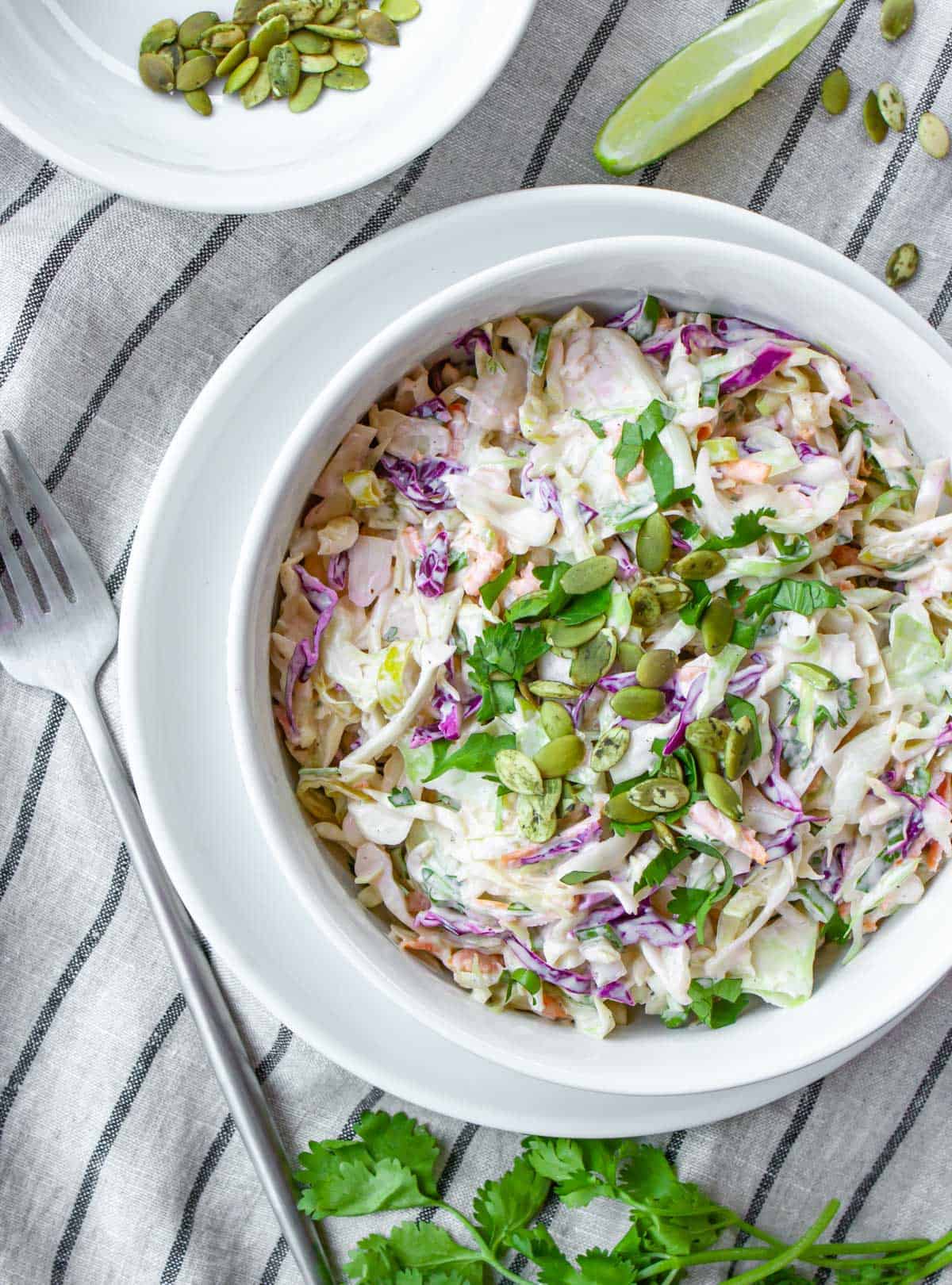
Jump to:
This healthy, sugar-free coleslaw recipe is so easy to make and is a delicious, classic summer side dish. A big heaping scoop is perfect to top off a pulled pork sandwich made with my Low-Carb Sandwich Thins and Slow Cooker Pulled Pork. Or, serve as a side with a savory filet of Indian Spiced Salmon.
I’ve turned up the volume on the flavors by adding cilantro, lime, pepperoncini and green onion. It’s a versatile slaw recipe to serve as a BBQ side dish with Smoked Flank Steak or an easy Traeger Pork Tenderloin. The creamy, sugar-free dressing is tangy and savory, with a hint of sweetness. It's actually a variation of my Cilantro Lime Salad Dressing, just a little bit thicker.
Why you'll love this recipe
- Healthy and delicious – this salad is a great way to eat your veggies! It's fresh and crisp with a light, creamy dressing
- Low-carb and sugar-free – using alternative sweetener keeps this low-carb, with just a little sweetness, like a classic slaw recipe
- Easy with simple ingredients – make a quick salad for BBQs, picnics and potlucks
- Special diet friendly – this is a keto-friendly, paleo and low-FODMAP coleslaw that can easily be altered to make an AIP and Whole30 coleslaw (see Variations, below)
Is coleslaw low-FODMAP and can you have coleslaw on keto?
Yes, this is both FODMAP-friendly and low-carb keto. Cabbage is naturally low in carbs and a healthy low-FODMAP vegetable. It pairs perfectly with my gluten-free coleslaw dressing that includes low-carb and FODMAP-friendly ingredients. Most dressings for slaw call for sugar that this recipe replaces with alternative sweetener. If you prefer, you can choose to leave the sweetener out entirely.
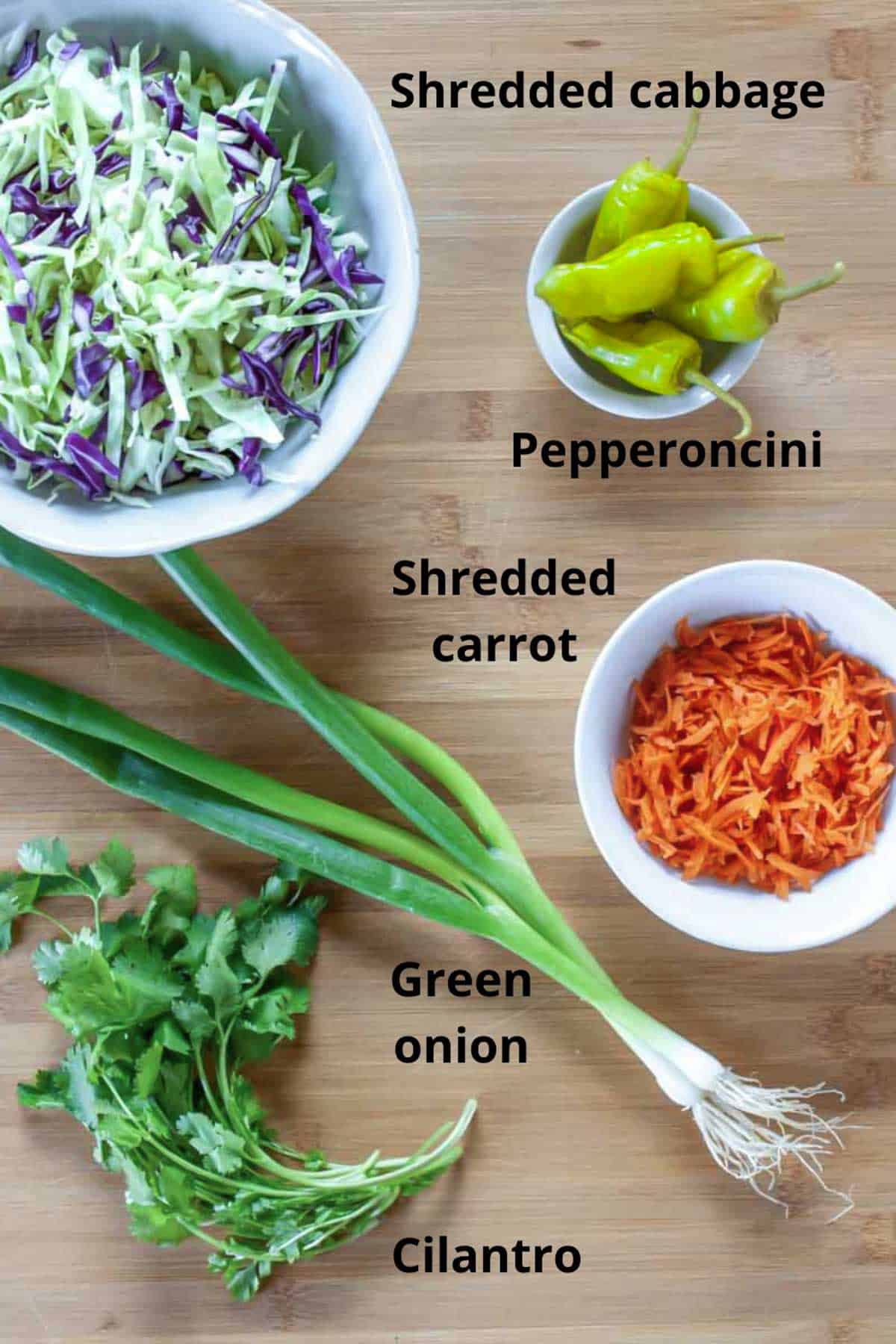
Salad ingredients
- Cabbage – you can use green or red cabbage or a combination of both. Chop or shred to your preferred texture using your food processor, knife, mandolin or box grater. You can use a pre-shredded bag of coleslaw mix or prepare from a whole head of cabbage. Definitely visit my How to Shred Cabbage post – it’s a deep dive into DIY cabbage shredding.
- Shredded carrots – these bring a splash of color, texture and a slightly sweet flavor. They add a very miniscule amount of carbs to the entire recipe, but feel free to leave them out if you wish. Freshly grated are best, but pre-shredded, bagged carrots work well, too.
- Green onion – finely sliced. For low-FODMAP, use only the green tops.
- Cilantro – this herb is amazing with cabbage and pairs so well with tangy, acidic lime
- Pepperoncini – these pickled peppers add tantalizing zing to the salad. Finely slice them for even distribution in the slaw. And, absolutely use the juice! Before slicing, I hold the pepper over the mixing bowl and slightly pierce the pepper with the tip of the knife, releasing the juice into the salad. If you’re following an AIP diet, simply eliminate these.
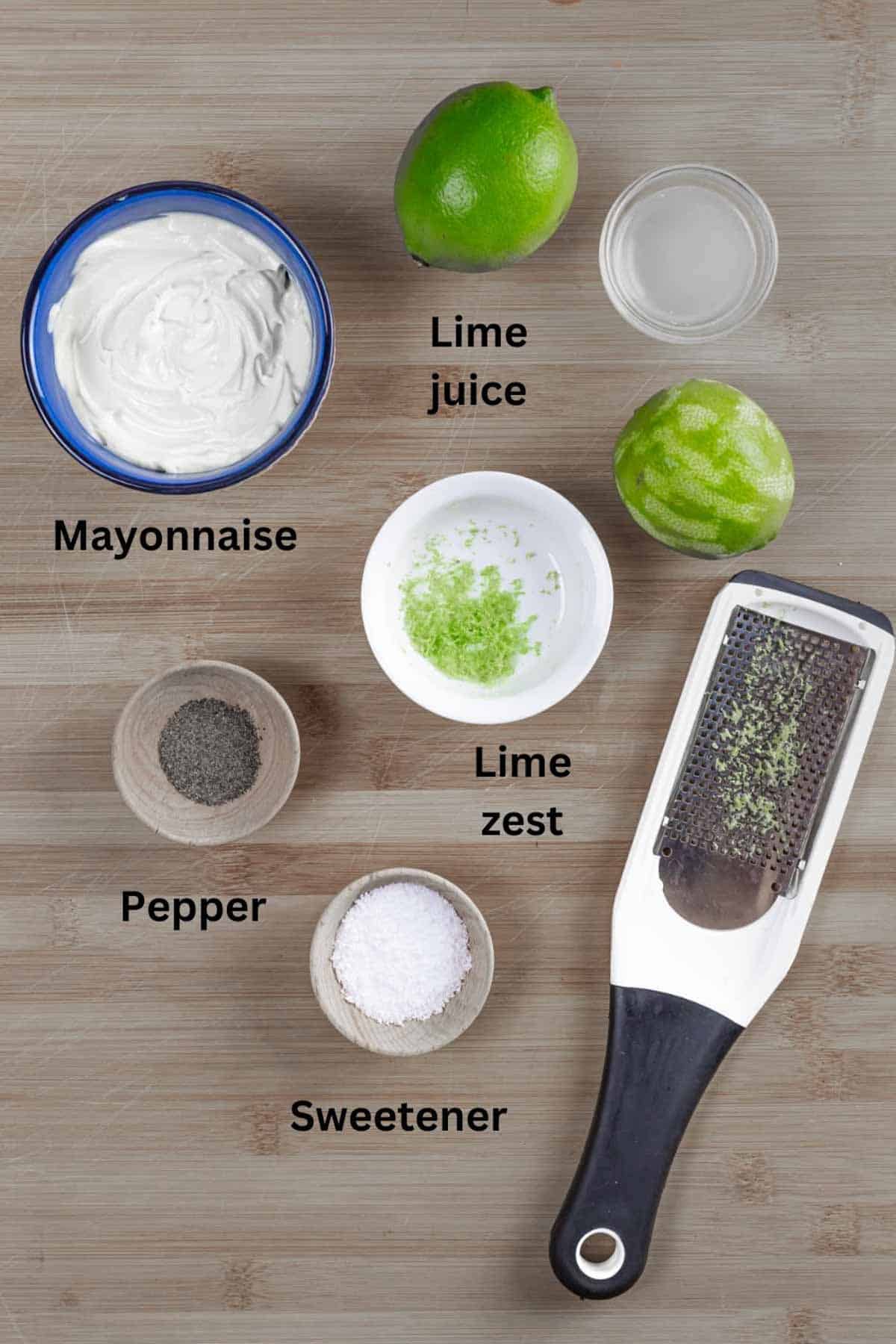
Dressing Ingredients
- Mayonnaise – creamy mayo gives this dressing that classic taste of traditional coleslaw. It adds a savory richness that keeps you coming back for more. For my AIP, low-FODMAP and Whole30 friends, make sure you check the label for any unwanted ingredients. Or, try making some from scratch.
- Lime juice and lime zest – zested lime and freshly squeezed juice adds a bright flavor and complexity when paired with the creamy dressing
- Sweetener – while totally optional, I like just a hint of sweetness in my slaw. Cabbage can have a slight bitterness when eaten raw and a touch of sweet can make a big difference. I like to use Swerve Confectioners sweetener or Stevia to keep this coleslaw dressing sugar-free.
- Salt and pepper to taste – as this salad is already bursting with flavor, I find I use very little of each. Black pepper adds some earthy notes. You may find that you don’t need to add salt at all, depending on what kind of mayonnaise you’re using. Feel free to eliminate it – you don’t want a salty coleslaw!
TIP: When choosing a sweetener to use, consider the size of the granules. Some sweeteners may not dissolve readily in the dressing and give a slight grainy texture. Using a powdered sweetener may be a better option.
Is cabbage low-FODMAP?
Monash University has tested several varieties of cabbage and found that green and red cabbage are low-FODMAP in serving sizes of less than ¾ cup. So, this is great news for cabbage lovers on a low-FODMAP diet! This recipe is made with a low-FODMAP salad dressing, so enjoy your coleslaw – just don’t go overboard on portion size and use a mayonnaise that's suitable for a low-FODMAP diet.
Keep in mind that cruciferous vegetables like cabbage contain an indigestible sugar called raffinose that may cause some digestive upset, especially for people with IBS or IBD.
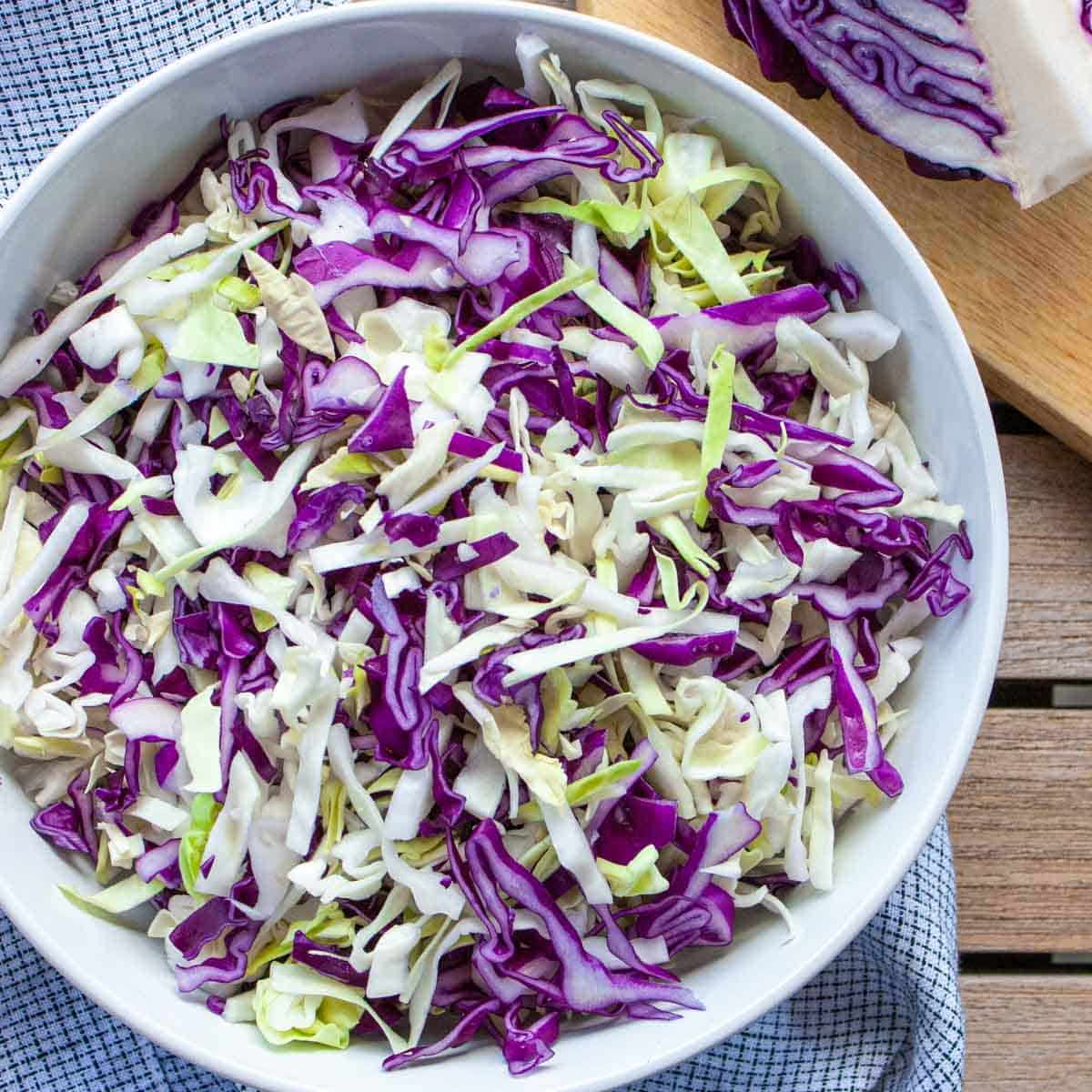
Shredding cabbage
Shredding your own cabbage is so easy and you’ll save money not having to buy a packaged coleslaw mix. And, you get to decide the texture of your cabbage slices for your slaw. Chopped, grated or sliced – it's entirely up to you.
You can use a chef's knife, a mandolin, a box grater (not my favorite method) or a food processor (the best!) to quickly prep a head of cabbage for your salad.
See my full post on How to Shred Cabbage for a deep dive into the different ways to cut and shred cabbage to make the perfect slaw.
Instructions
This easy side dish comes together in just minutes (and tastes better than anything you'll find at the deli counter):
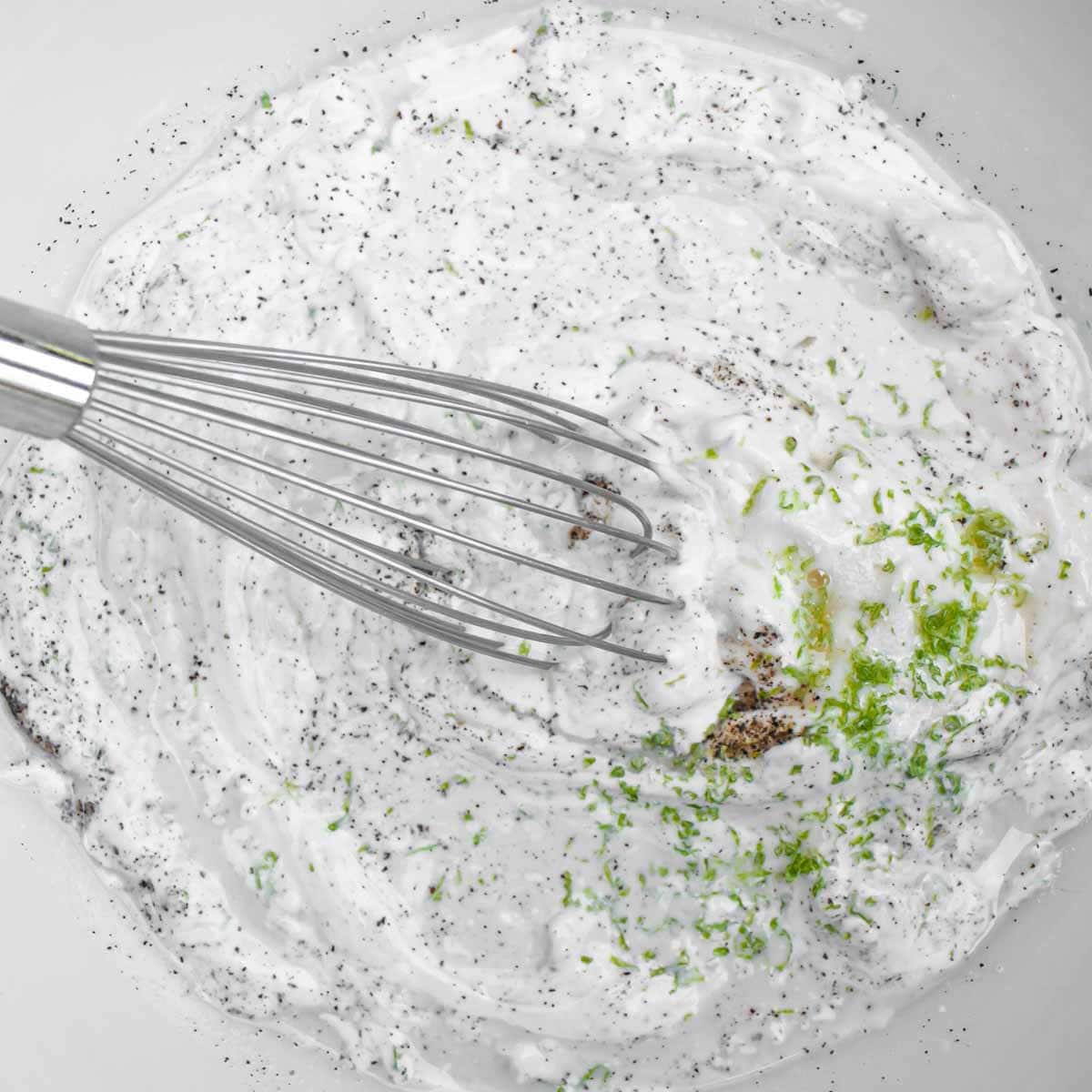
In a large bowl, combine all of the dressing ingredients and whisk until thoroughly combined.
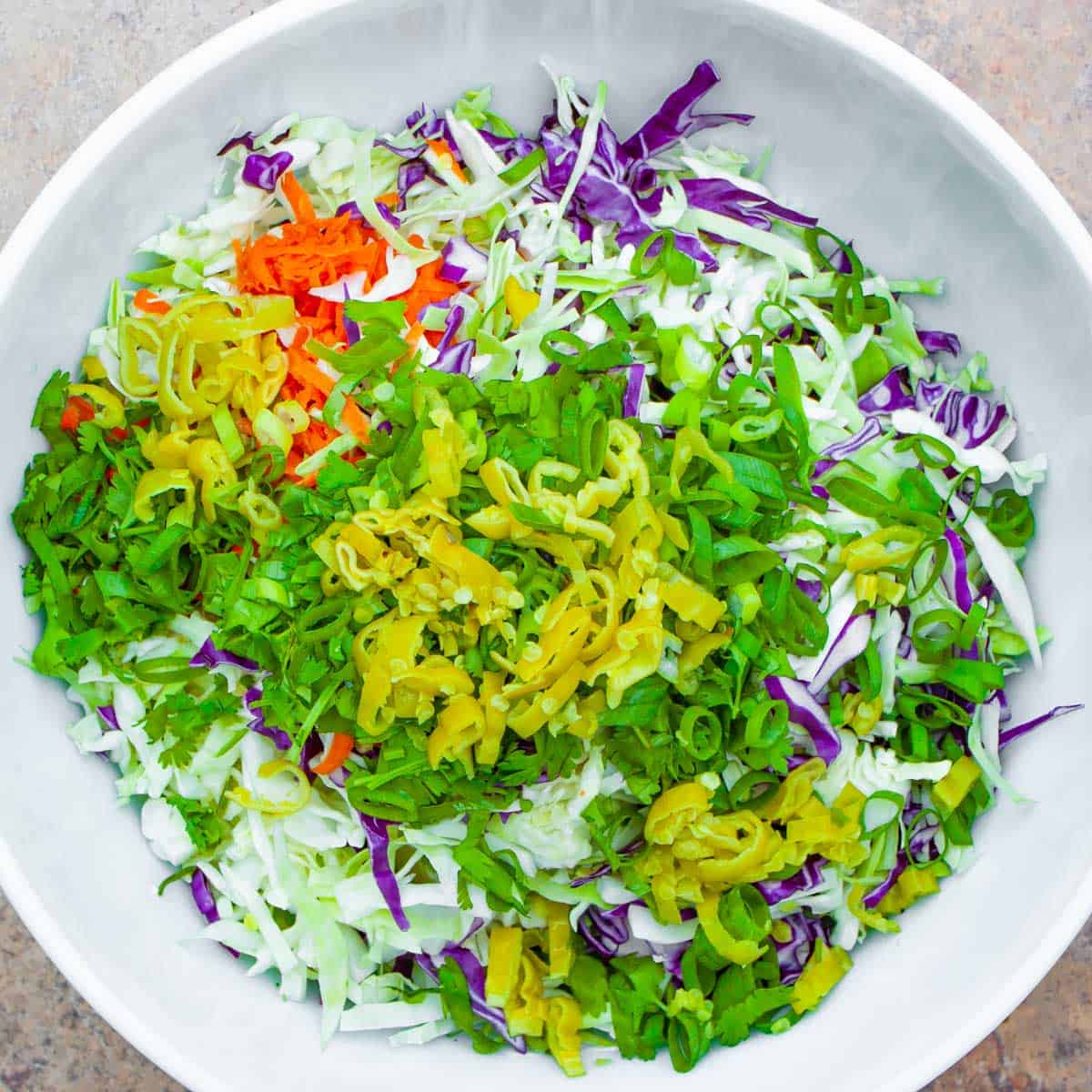
Add the chopped and shredded vegetables to the bowl and mix. Make sure to scrape the bottom of the bowl to incorporate all the dressing.
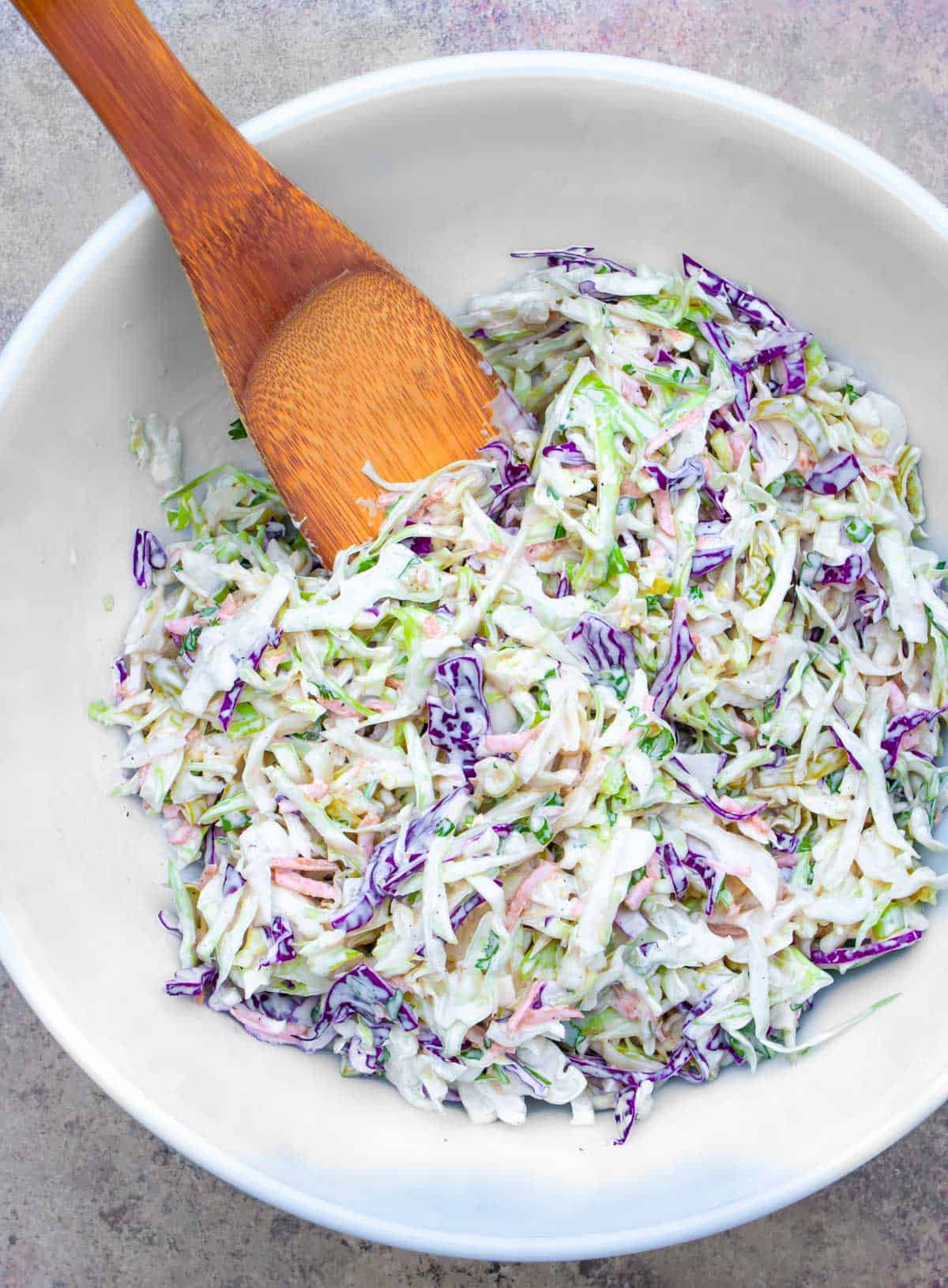
TIP: I like to make coleslaw using just one large bowl, rather than making the dressing in a separate container, then combining everything in another bowl. It’s one less dish to wash!
How to Store
Store in an air-tight container for up to 5 days. After a couple of days, the cabbage may release some water. Simply drain it off the salad or stir it in. Add a dollop of additional mayo, if needed.
Variations
- AIP coleslaw – omit the pepperoncini and black pepper. Be sure you use an AIP friendly mayonnaise. If you want an extra ‘zing’ to the salad, add a touch of apple cider vinegar or some grated horseradish for an extra bit of heat. It’s divine!
- Whole 30 coleslaw – omit the sweetener and try adding finely chopped dates, dried currants or other dried fruit, such as apricots. They will add a few extra carbs, but so much flavor!
- Add toppings – bacon bits, sliced almonds, pepitas (pumpkin seeds) or hemp, chia or sunflower seeds add extra flavor and crunch
- Top with crumbled cheese – Cotija cheese is a perfect dry, salty, crumbly addition
- Spices – add ¼ teaspoon of homemade Tikka Masala Powder for some additional umami and wow factor!
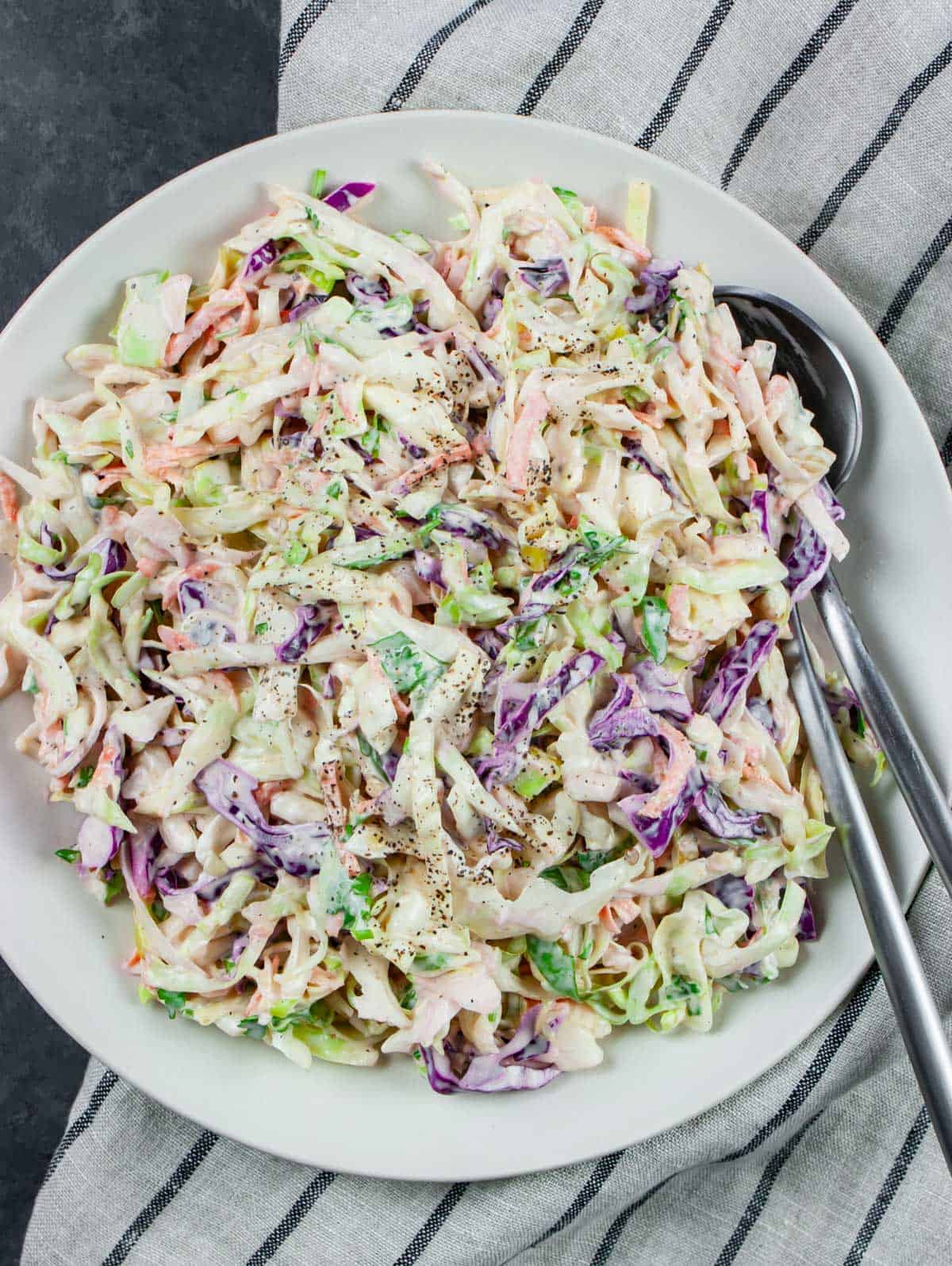
Serving suggestions
- Pair with pulled pork – for a busy weeknight meal, serve this creamy keto coleslaw alongside Crock Pot Pulled Pork or plop a large scoop on top of a pulled pork sandwich made with Low-carb Sandwich Thins. It's the best accompaniment for pulled pork!
- As a side dish – coleslaw makes a perfect side for smoked Traeger Beef Ribs, Smoked Flank Steak, Smoked Pork Tenderloin or any other summer barbecue favorites
- Taco topping – try this as a cabbage taco slaw to top some Easy Keto Carnitas tacos or fish tacos. And don’t forget to add some Low-FODMAP Guacamole!
- Lettuce substitute – use it in place of lettuce on burgers, sandwiches, in wraps or burritos
FAQ
Most coleslaws are gluten-free, but with store-bought pre-made slaws, it's difficult to know for sure. There are some certified gluten-free dressings that can be used, but making from scratch is the best way to ensure it's gluten-free.
If kept sealed in the refrigerator, it can last up to 5 days. The cabbage may release some water that can be drained off or simply stirred into the salad.
Yes! Store it in the freezer in a tightly sealed, freezer-safe container. Make sure you eat it within 6 months. The quality will start to decline and there’s a potential for freezer burn if frozen for longer.
After it’s thawed, the cabbage will release some water that can be drained off or stirred back into the salad.
With an outstanding nutrient profile, cabbage can be considered a ‘superfood’. It’s a nutritional powerhouse and is high in vitamins C and K, as well as other antioxidants. It may help prevent certain diseases, decrease inflammation and improve digestion, due to its high fiber content.
Many pre-packaged coleslaws contain sour cream or yogurt and are not dairy-free. Always be sure to read the ingredients so you know for sure. Homemade dairy-free coleslaw is not only more economical, but you know exactly what's in it!

What to serve with sugar-free coleslaw
Did you make this recipe? Let me know how you liked it by giving a star rating and leaving a comment!
📖 Recipe
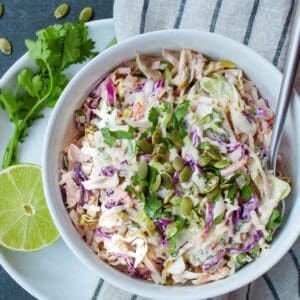
Cilantro Lime Gluten-free Coleslaw (dairy-free and low-FODMAP)
Ingredients
For the salad
- 1 medium cabbage (about 6 cups or 8-10 oz, shredded)
- 2 green onions (green part only for low-FODMAP)
- ½ cup carrots (shredded or thinly sliced)
- ½ cup cilantro (chopped)
- 4 pepperoncini (large - thinly sliced)
For the dressing
- 1 cup mayonnaise
- 2 tablespoons lime juice
- 1 teaspoon lime zest
- ¼ teaspoon black pepper
- salt (to taste)
- 2 teaspoons stevia (use sweetener of choice)
Instructions
- Combine the salad dressing ingredients in a large bowl and whisk together to combine.
- Add the sliced and chopped vegetables to the bowl and mix.
- Add salt and pepper to taste.
Notes
Variations
- AIP coleslaw – omit the pepperoncini and black pepper. Be sure you use an AIP friendly mayonnaise. If you want an extra ‘zing’ to the salad, add a touch of apple cider vinegar or some grated horseradish for an extra bit of heat. It’s divine!
- Whole 30 coleslaw – omit the sweetener and try adding finely chopped dates, dried currants or other dried fruit, such as apricots. They will add a few extra carbs, but so much flavor!
- Add toppings – bacon bits, sliced almonds, pepitas (pumpkin seeds) or hemp, chia or sunflower seeds add extra flavor and crunch
- Top with crumbled cheese – Cotija cheese is a perfect dry, salty, crumbly addition
- Spices – add ¼ teaspoon of homemade Tikka Masala Powder for some additional umami and wow factor!
Nutrition
*Net carbs = carbohydrates - fiber
Nutritional information is an estimate, calculated using online tools and does not include optional ingredients unless otherwise indicated.

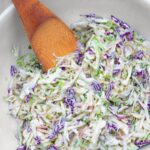
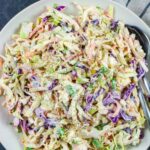
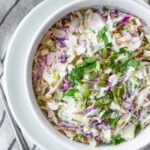
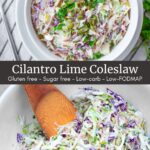
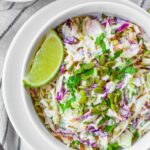
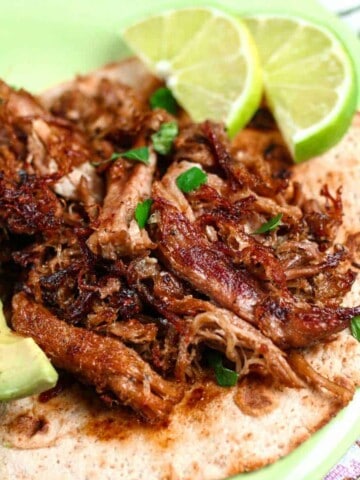

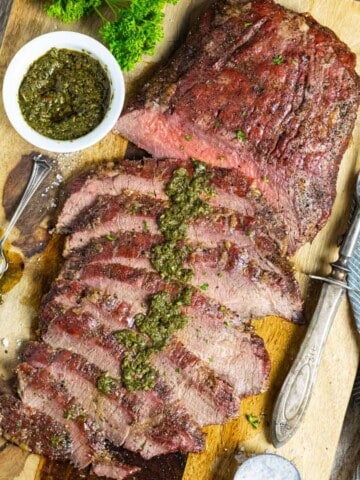

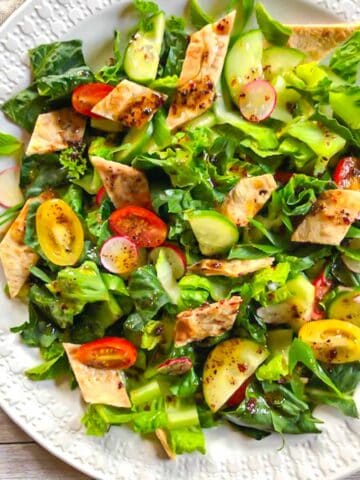
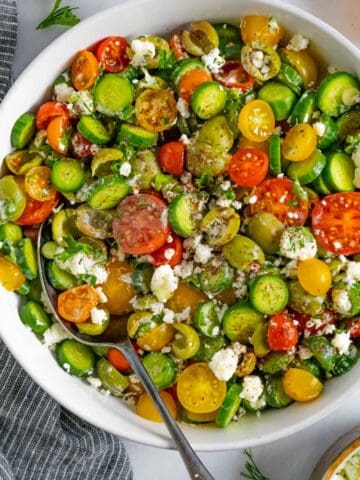
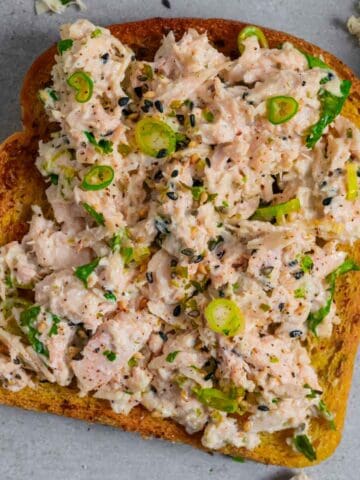
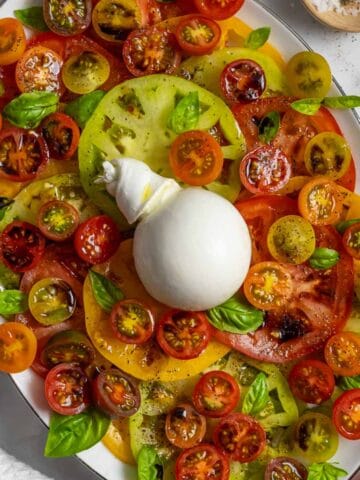
Joel says
Best ever, hands down.
Tracey Hatch-Rizzi says
Hi Joel,
I'm so happy to hear you liked the recipe! It's definitely one of my favorite things!!
Take care,
Tracey